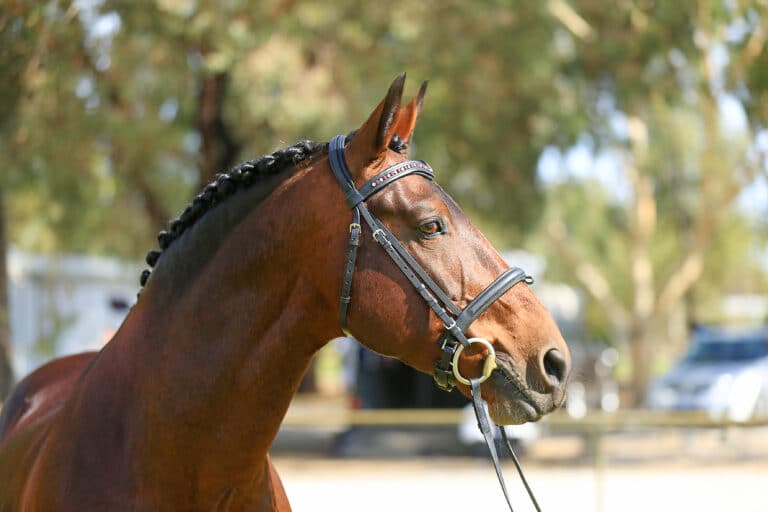If you’re looking for a strong, resilient, long-lived and versatile horse with a kind temperament, you’re likely to meet your match in the glorious shape of a Cleveland Bay, writes SUZY JARRATT.
Believe it or not, Buffalo Bill and the Duke of Edinburgh had something in common – both drove teams of Cleveland Bays. One used them to pull stagecoaches in his Wild West Show, and the other to compete in international driving competitions.
When the American showman visited England to perform for Queen Victoria he borrowed some Cleveland Bays and was so impressed he took some home with him. When 50-year-old Prince Philip gave up polo because of an arthritic wrist, he wanted to find another exciting activity. In a 2017 interview he said: “I suddenly thought, well, we’ve got horses and carriages so why don’t I have a go at driving. So I borrowed four horses from the stables in London (the Royal Mews), took them to Norfolk and practiced.” He went on to win many prestigious driving events.
Cleveland Bays and mountain gorillas also have something in common – both are critically endangered. Recent estimates indicate there are about 800 gorillas left in the world and approximately 400 purebred Cleveland Bays, with only a score or more in Australasia.
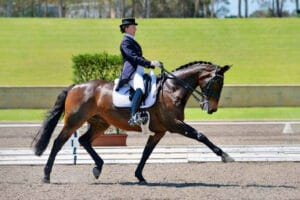
Named after the hilly region of Yorkshire in north east England, the Cleveland Bay is one of the country’s oldest horse breeds. Developed during the Middle Ages, its ancestors were used as packhorses, which were crossbred with Andalusian and Barb blood and later with Arabians and Thoroughbreds. Over the years the frame lightened as they became popular options for riding and carriage horses. In type (not in blood) the breed is most closely related to the Irish Draught.
The Cleveland Bay bloodline aided in the refinement of the Oldenburg breed, as well as creating and improving the Hanoverian and Holstein. And with French and Belgium draughts, it was instrumental in the development of the Vladimir Heavy Horse in Russia.
Members of the British Royal family have been patrons of Cleveland Bays throughout the breed’s history. King George V bred them in the 1920s and when numbers reached an all-time low following the two world wars, his granddaughter, Queen Elizabeth II, stepped in to help replenish the population. In 1961 their popularity rose when she purchased Mulgrave Supreme, a purebred colt destined for America, and stood him at public stud for pure and partbred mares.
Queen Elizabeth is the breed’s patron and the Royal Mews continues to house several of these horses for the purpose of drawing ceremonial vehicles. The breed is also used by the Imperial House of Japan, which imports them to pull the lacquered carriages which transport visiting ambassadors to the palace. The horses are trained to remain calm amid the hectic Tokyo traffic.
This is a strong, well-mannered and agreeable horse which has greatly influenced other bloodlines, yet there are very few purebreds here, or elsewhere. Partbreds and Cleveland Bay (CB) Sporthorses (see definitions below) are prolific in various equestrian disciplines. In both Australia and overseas home bred CB/Thoroughbreds have shone in the show ring
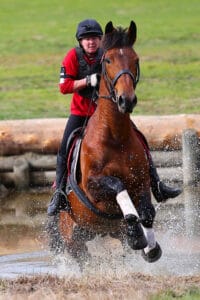
In 2006, Toowoomba’s internationally acclaimed four-in-hand driver Bob Edwards competed his team of Sporthorses at WEG. One of them he sold to fellow Australian and world champion driver Boyd Exell. Carrington Park Ajax, a.k.a. Junior, was by Wetherby Royal Pathfinder, whose lineage goes back to the renowned Mulgrave Supreme. Junior formed part of Exell’s team as the ‘right wheeler’ at every FEI World Cup until 2015. When he retired the horse at the closing of the Cup in Bordeaux, Boyd escorted the 25-year-old out of the arena, walking beside him while his navigator drove the team.
Atalanta, by Emperor Oberon out of a Thoroughbred mare, was owned by Carolyn Begg of Rainbow Flat, NSW. The mare, nicknamed Tally, came from Carrington Park in Oberon NSW where she was bred to be part of a carriage team but grew too big. She was then trialled and rejected by a jumping rider who dismissed her as ‘stupid’. “Far from it,” recalls Carolyn. “From the moment we began dressage training she listened to the aids and in ten minutes was working on the bit. Her calm temperament never changed.” The mare won and placed at all levels around the country, qualifying for WEG in the late nineties. “Sometimes Tally got very scared but she always tried, she was a horse in a million,” Carolyn adds.
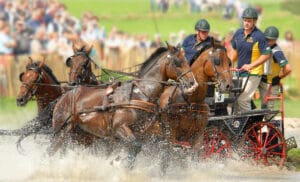
Melissa Alexander says the same about her mare. A Level 1 instructor and Principal of Riding with Confidence in Victoria’s Yarra Valley, she purchased Gift of Killarnie in 2000. “I first saw her in a paddock. She had the most amazing dapples and a presence which commanded attention. She jumped, hacked, was cheap to feed and didn’t need shoeing. Bold and fearless she got me back eventing after ten years away. She placed in the Led Show Hunter at Barastoc under an international judge, and for two consecutive years was Supreme Champion led Cleveland Bay at Melbourne Royal, as well as Champion Ridden. She was a true all-rounder.”
Brenda Boaden is the registrar of the Cleveland Bay Horse Society of Australasia (CBHSA). She has imported several purebreds to her Ferndale Springs Stud in West Coolup, WA. Tregoyd Topper came from Wales in 2007, just after winning the King George V Cup, a prestigious invitation-only event for premium stallions. “We’ve bred about fifty foals from him, some crossbreds and a high number of purebreds,” Brenda says, who over the years has outlaid over $100,000 transporting three adult horses from the UK. “A mature Cleveland Bay takes up a double bay on a plane so it costs twice as much to fly them!” she laughs.
But surprisingly they don’t cost too much to feed. When it comes to catering for a muscular 16.2hh bay, Brenda believes they are a most economical large horse: “They don’t require grain or high-energy diets, and they also have great bone and tough, dense feet.” These hooves, which are blue underneath, rarely need shoeing. “They’re also very trainable,” she adds.
She laments that despite all these positives they are underrated and undervalued: “But I’m all about preserving and generating a wider interest in the breed. Recently one of mine went to Brisbane, and shortly one of my purebred mares, Ferndale Springs Lotus, is going to New Zealand. She’ll be the only one in that country.”
CBHSA president Karen Bodily has several CBs, as well as some Friesians, at her stud in Kokardine Park, WA. “Impeccable Emily is a purebred from whom I’ve had two pure and one partbred. What I’d like to see are more events and festivals where they can be showcased. Some heavy horse extravaganzas hold classes for them but these are few and far between,” she explains. “They’re one of the purest breeds in the world and because of their purity many Warmblood people are using them in their breeding programs, and the partbreds and Sporthorses continue to demonstrate their talent and versatility.”
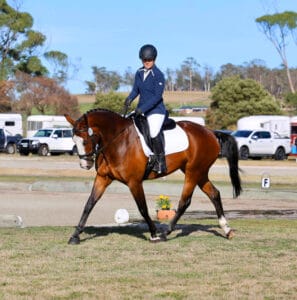
Another sport they’re ideal for is vaulting. Brigadoon, a partbred gelding, has carried many aspiring equestrian gymnasts, quietly tolerating their falls and mid-air mistakes. “His rhythm and temperament are great,” says Mike Winwood, from Greenbank, Brisbane, who founded the Kingfisher Vaulters in 2004. The club has since evolved to Young Stars on Horseback with achievements at state, national and international competitions. “We found him doing dressage in a stock saddle in Roma – they do things differently out there! We brought him home and he was ideal,” Mike tells me. A vaulter has to jump on to a horse as it’s moving and Brigadoon quickly learnt not to automatically stop when the rider was preparing to mount.
Two riders who trained on him were Rachel Barlow and Jerri Dixon, both represented Australia at WEG 2018. “They placed tenth in the pas de deux,” Mike says. “Some vaulters use Clydesdale, Shire or Percheron crosses as their backs are very flat but they don’t move as well at the canter. Whereas Brigadoon and horses like him are perfect. Big boned, strong and beautifully balanced.”
Partbred Cleveland Bays
A partbred Cleveland Bay must be bay in colour and be a minimum 50 per cent either by a registered purebred stallion or out of a registered purebred mare. Breed standards are as per purebred Cleveland Bays.
Cleveland Bay Sporthorses
Not a breed as such, but the term given to any crossbred Cleveland Bay which may have as little as 12.5 per cent Cleveland Bay blood. Because of the genetic influence of the horses they’re crossed with, CB Sporthorses are not limited to the bay colour.
Want to know more? Visit the Cleveland Bay Horse Society of Australasia at cbhsa.com.au
Feature Image: Billara Beersheba, a three-quarter Cleveland Bay x Thoroughbred stallion owned by the Reigate Stud in SA (Image by Michelle Williams).

